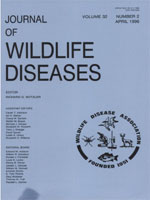M. D. Samuel, D. R. Goldberg, C. B. Thomas, P. Sharp, J. R. Robb, G. L. Krapu, B. N. Nersessian, K. P. Kenow, C. E. Korschgen, W. H. Chipley, M. J. Conroy
Journal of Wildlife Diseases 32 (2), 331-337, (1 April 1996) https://doi.org/10.7589/0090-3558-32.2.331

KEYWORDS: Mycoplasma anatis, serology, enzyme-linked immunosorbent assay, ELISA, wild ducks, Pekin, mallard, Anas platyrhynchos, Canvasback, Aythya valisineria, American Black Duck, Anas rubripes, mycoplasmas, survey
We developed an ELISA procedure to assess the presence of M. anatis-specific serum antibody in ducks. Sera from exposed and unexposed Pekin ducks (Anas platyrhynchos) were used to standardize the ELISA and to establish reference ranges to classify ELISA results as exposed or not exposed. We conducted serological surveys of female waterfowl in the central and eastern United States between 1988 and 1992 to assess the frequency of exposure in wild waterfowl. Adult breeding mallards (Anas platyrhynchos), wintering mallards, and black ducks (Anas rubripes) had high prevalences of exposure to M. anatis (25% to >80%). In comparison, none of the breeding adult canvasbacks (Aythya valisineria) had serum antibody levels indicating exposure. Approximately 50% of the juvenile mallards and black ducks were exposed to M. anatis by 8 months of age, indicating high transmission rates among wild birds.

